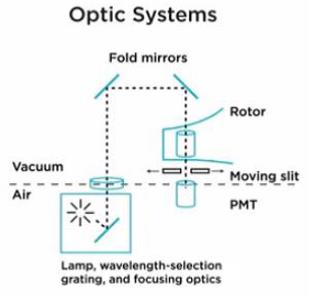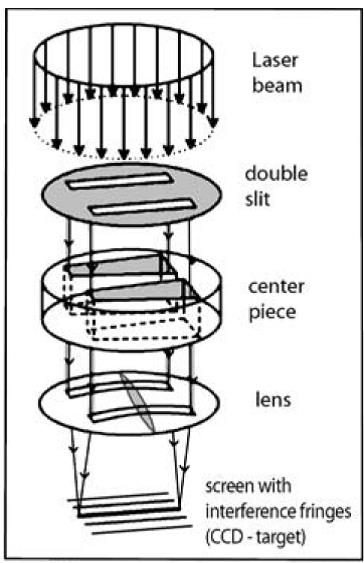Optical Systems Used for AUC
The basic measurements provided by AUC are radial concentration distributions, or scans, acquired at intervals ranging from seconds (for velocity sedimentation) to hours (for equilibrium sedimentation). As the rotor spins, scans are generated when the cell passes through an optical detector’s path.
Optical systems currently used for AUC include, absorbance spectrophotometers and Rayleigh interferometers.

Scans are generated when a sell passes through the optical detector's path.
Absorbance spectrophotometry
The most frequently used detector for AUC, an absorbance optical system (i.e., a double-beam spectrophotometer), is considered the easiest to use. The increased sensitivity of absorbance optics enables examination of samples in concentrations too dilute for interference optics.
The basic process for obtaining an absorbance scan includes four steps:
1. A high-intensity xenon flash lamp—which enables use of wavelengths from 190 to 800 nm—fires briefly as a selected sector passes the detector’s path.
2. Cells and individual sectors are examined in turn, with timing information provided by a reference magnet in the rotor’s base.
3. A slit below the sample moves to enable sampling of different radial positions.
Rayleigh interference optics
This technique relies on the principle that light velocity decreases as it passes through a region of higher refractive index. With interference optics used for AUC, monochromatic light passes through two fine parallel slits, one below each sector of a double-sector cell. One cell contains a sample of solution and the other contains a sample of solvent in dialysis equilibrium.
Light waves emerging from the entrance slits and passing through the two sectors undergo interference to yield a band of alternating light and dark “fringes.” When the refractive index in the sample sector is higher than in the reference, the sample wave is impeded relative to the reference wave. This causes the positions of the fringes to shift vertically in proportion to the concentration difference relative a reference point.
Because the signal from an interference optical system does not rely on a chromophore, colorless compounds (e.g., polysaccharides and lipids) can be characterized by AUC. In fact, any material with a refractive index different from the reference will contribute to an interference signal.
Unlike an absorbance system, the interference signal has very little stochastic noise. Stress on the optical components, however, can lead to refractive index changes, so sapphire windows should always be used with an interference optical system. Careful alignment and focusing are also necessary for obtaining accurate results from interference optics, but after they are properly aligned and focused, interference optics will remain stable for an extended period of time.


